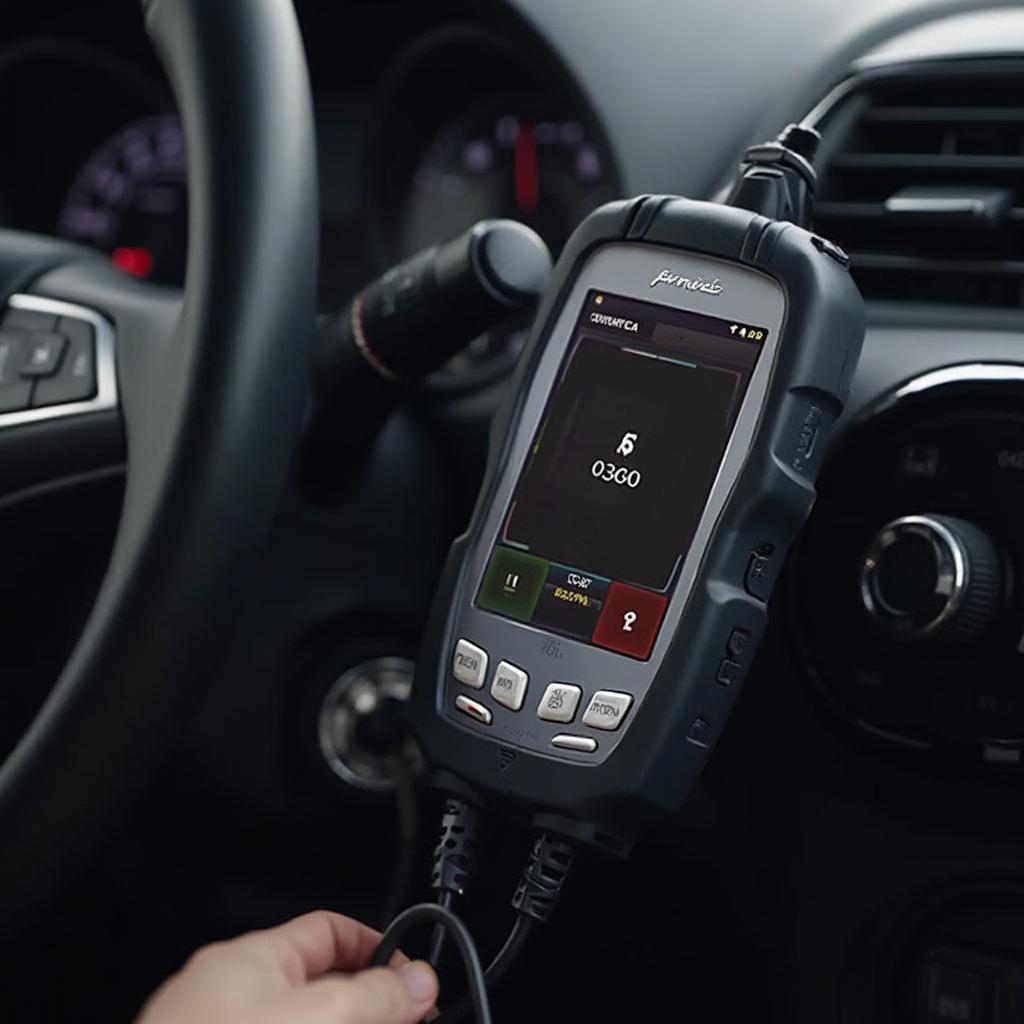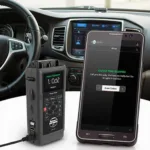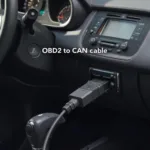If your OBD2 code reader displays the dreaded P0300 code, it signals a random or multiple cylinder misfire. This means your engine isn’t burning fuel efficiently in one or more cylinders, and it’s a problem you need to address. Understanding what P0300 means, its causes, and how to fix it can save you time, money, and frustration.
Decoding the P0300 OBD2 Code
The P0300 code indicates a random misfire, meaning the problem isn’t consistently occurring in a specific cylinder. This makes diagnosing the issue a bit more challenging than a code like P0301 (misfire in cylinder 1), for example. It essentially tells you something is wrong, but not exactly where to look first. This code is a general indicator, and further investigation is required. After getting this code, it’s recommended to check for other more specific codes, such as actron obd2 pocketscan codes.
 P0300 Code Displayed on an OBD2 Reader
P0300 Code Displayed on an OBD2 Reader
What Causes a P0300 Code?
Several issues can trigger a P0300 code. These range from relatively simple fixes like a bad spark plug to more complex problems like a faulty fuel injector or a vacuum leak. Here’s a breakdown of the common culprits:
- Faulty Spark Plugs or Wires: Worn-out spark plugs or damaged wires can prevent the spark needed for ignition, leading to misfires.
- Vacuum Leaks: Leaks in the intake manifold or vacuum hoses can disrupt the air-fuel mixture, causing combustion problems.
- Fuel Injectors: Clogged or malfunctioning fuel injectors can prevent the correct amount of fuel from reaching the cylinders.
- Low Fuel Pressure: Insufficient fuel pressure can starve the engine of fuel, resulting in misfires.
- Ignition Coil Problems: A failing ignition coil can weaken or prevent the spark from reaching the spark plugs.
- Oxygen Sensor Issues: A faulty oxygen sensor can provide incorrect information to the engine control unit (ECU), leading to an improper air-fuel mixture.
- Catalytic Converter Problems: Although less common, a failing catalytic converter can sometimes cause misfires.
- Mechanical Issues: In some cases, internal engine problems like worn piston rings or valves can contribute to misfires.
How to Diagnose and Fix a P0300 Code
Diagnosing a P0300 code requires a systematic approach. Here’s a step-by-step guide to help you pinpoint the problem:
-
Check for Other Codes: See if there are any other codes accompanying the P0300, as they can provide more specific clues. Perhaps you have questions about specific car manufacturers like saab obd2 or maruti suzuki obd2.
-
Inspect Spark Plugs and Wires: Check for signs of wear, damage, or fouling. Replace them if necessary.
-
Check for Vacuum Leaks: Inspect vacuum hoses for cracks or loose connections. Use a carburetor cleaner to spray around potential leak areas while the engine is running; a change in engine idle speed indicates a leak.
-
Test Fuel Pressure: Use a fuel pressure gauge to ensure the fuel pump is delivering adequate pressure.
-
Inspect Fuel Injectors: Test the injectors for proper operation using a multimeter or a dedicated fuel injector tester. Consider how information about a specific car model like 2003 buick park avenue specs obd2 can be helpful.
-
Check Ignition Coils: Test the coils using a multimeter or an oscilloscope. Refer to resources like how to use auto drive obd2 eobd code reader for guidance.
-
Check Oxygen Sensors: Use a scan tool to monitor the oxygen sensor readings.
What if the Problem Persists?
If you’ve checked all the common causes and the P0300 code persists, it’s time to consult a qualified mechanic. They have the expertise and specialized tools to diagnose more complex issues, such as internal engine problems.
“A P0300 code can be tricky,” says John Smith, ASE Certified Master Technician. “While sometimes it’s a simple fix, other times it requires a deeper dive. Don’t hesitate to seek professional help if you’re unsure.”
Conclusion
The P0300 OBD2 code, indicating a random misfire, requires careful diagnosis. By understanding the potential causes and following a systematic approach, you can effectively address the problem and restore your engine’s performance. Ignoring this code can lead to further damage and costly repairs, so prompt action is crucial.
FAQ
- Is it safe to drive with a P0300 code? It’s best to avoid driving extensively with a P0300 code as it can damage your catalytic converter and other engine components.
- Can bad gas cause a P0300 code? While less common, contaminated fuel can contribute to misfires.
- How much does it cost to fix a P0300 code? The cost varies depending on the underlying cause. A simple spark plug replacement is relatively inexpensive, while more complex repairs can be significantly more costly.
- Can I fix a P0300 code myself? If you’re mechanically inclined, you can address some of the simpler causes. However, more complex issues may require professional assistance.
- What other codes are often associated with a P0300? Codes like P0301 through P0308 (indicating misfires in specific cylinders) can accompany a P0300.
If you need further support, please contact us via WhatsApp: +1(641)206-8880, Email: cardiagtechworkshop@gmail.com or visit our office at 789 Elm Street, San Francisco, CA 94102, USA. Our customer support team is available 24/7. You can also explore other helpful articles on our website.

